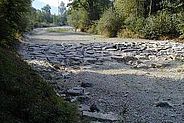
Weather and climate extremes and drought ¶
Weather extremes, such as droughts, heatwaves and storms, are becoming more frequent in Switzerland as a result of climate change. Our research is creating a knowledge base for better forecasts and adaptation strategies and investigates the consequences of such events.
Contents ¶
Switzerland is already registering more very warm days and fewer very cold nights than fifty years ago. This is in line with expectations: Worldwide, climate change is expected to result in less pronounced cold, but more and more intense heat extremes and heavy precipitation. Events are considered extreme if they deviate markedly from a long-term average. Examples include the dry phase in the summer of 2018 or the floods in July 2021.
Drought and ecosystems ¶
At WSL, we are dedicated to the early detection and impact of such extreme situations on the population and ecosystems. For example, together with the FOEN and MeteoSwiss, we operate the Drought-CH information platform for the early detection of drought. It is aimed at municipalities, hydropower plants and farmers.
Pronounced droughts or other consequences of climate change also have an impact on forests. Without adaptations in their management or species composition, forests will no longer be able to fulfill important functions - such as water treatment or protection against avalanches - to the same extent in the future. We provide basic knowledge so that forest services, managers and policymakers can correctly assess the climate risks and the adaptive capacity of forests and take effective adaptation measures.
With increasing drought, the risk of forest fires is also rising. WSL collects data on forest fires and develops methods for their prevention.
Extreme events such as pronounced heat waves can also have an impact on the economy and society. We are therefore also investigating political and economic strategies and processes, for example for adapting to climate change.
